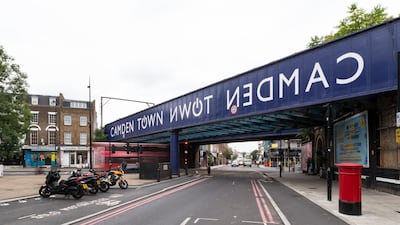Plans to create an innovative "high line" park in one of London's most diverse districts using a section of disused railway came a step closer to being achieved on Tuesday after the mayor Sadiq Khan pledged financial support for the project.
The Camden Highline is a regeneration scheme being led by the multi-award winning local business group Camden Town Unlimited (CTU), which is hoping to turn just under a mile of abandoned land owned by the British government body Network Rail into a new public park and garden walk.
With hopes of rivalling New York's High Line, which opened in 2009, the proposed park would provide a pedestrian and cycle route linking Camden Market to King's Cross.
Camden Town Unlimited took on the ambitious challenge last year after its CEO, Simon Pitkeathley, was alerted to its potential by a study by University College London academic Oliver O'Brien published in a local newspaper.
Mr O'Brien had examined areas of abandoned railway across London that could potentially be used for a high line park and identified the 8 metre high and 18 metres wide elevated railway as the most achievable.
For CTU, which owns Camden Collective, a charity which gives away free spaces to start-ups, it was an opportunity that simply had to be explored.
Mr Mr Pitkeathley, who also sits on the London Enterprise Panel, told The National: "The Highline grabbed our attention because we thought it was a really cool project. What would that do for Camden and what would that do for London?
"It seemed pretty adventurous and a bit scary but we like a big challenge."
Crowdfunding Introduction from Camden Highline on Vimeo.
However, for Mr Pitkeathley it was essential to get the support of the local community first before embarking on such a huge operation, which was where the crowdfunding campaign began.
CTU became one of 25 organisations to take part in the mayor of London's Crowdfund London programme, which gives local groups the opportunity to pitch ideas to transform their communities and receive donations towards their project using the crowdfunding platform Spacehive.
The business group decided this would be the perfect way to see whether Camden residents were interested in the Highline and so appealed for people to pledge their support to fund the first stage of the project, an in-depth survey of the area.
"We wanted to know that people in and around Camden were up for this because we figured it was not going to be easy," Mr Pitkeathley continued. "If people really didn't want it then they wouldn't support the campaign, so this was a good way of finding out."
Luckily the idea has proved to be a hit with residents, so much so that at the time of writing, the Camden Highline has achieved £34,426 (Dh166,200) of its £37,420 target to pay for the scoping works. Spacehive works on an all or nothing model, so projects must reach their targets or they will not receive any of the money.
As well as backing from residents, some of whom have pledged up to £500 individually, the Camden Highline also has the support of other local businesses, Camden Council and the mayor, who donated £2,500 during a live fundraising event at City Hall last week.
"This innovative project has the potential to become a real asset for Camden and is a great example of a local community taking an idea and garnering support in order to make it a reality. I look forward to seeing it developed," Mr Khan said.
The crowdfunding campaign was designed to let local people feel that they had an ownership in the project, learning from the lesson of another failed regeneration scheme, the proposed Garden Bridge, which would have been a pedestrian walkway linking north and south sides of the River Thames.
"Given the history of the Garden Bridge and that sense that it wasn't really owned by the people who would be directly affected by it, we were keen that this become something that the local community in all its diverse aspects owns." Mr Pitkeathley added.
However, looking to the future of the actual building of the Highline, it is clear that crowdfunding as the sole way of raising cash for a big project would not be a viable option.
"When it comes to the big build, we'll need some serious money and I think there's been some doubt about the amount you can realistically raise through crowdfunding," Mr Pitkeathley explained.
But the experience has led Mr Pitkeathley to consider the role that the 21st-century fundraising method can have in other large-scale regeneration projects across London.
"I think crowdfunding has a part to play in the future. The reality is that the value of land in London is so great that these sort of projects can only have peripheral impact," he reasoned. "But I think that collective pressure from the community can have an effect on the way some of these buildings are designed and integrated.
"You would never get a crowdfunding community owning any huge buildings because the numbers don't stack up. But it doesn't mean you can't play a part."


